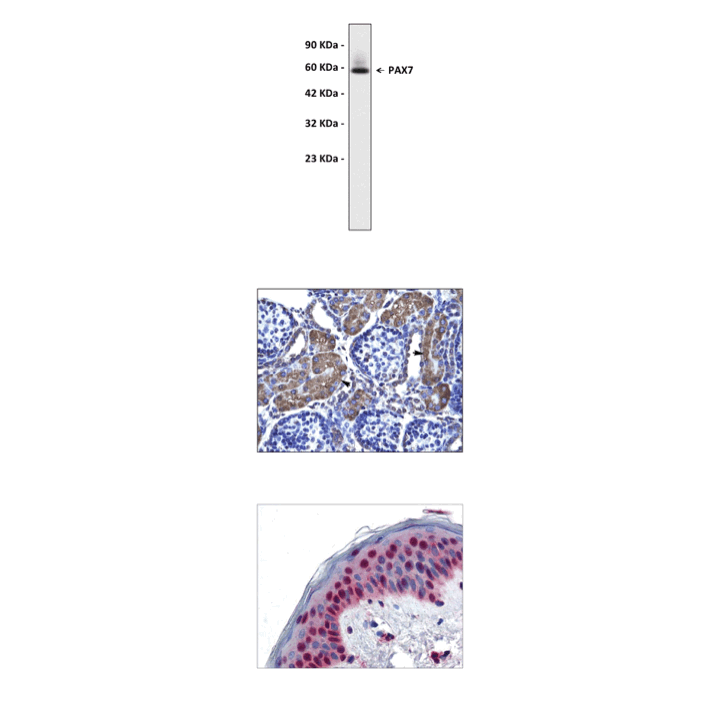Anti-PAX7: Rabbit PAX7 Antibody |
 |
BACKGROUND Several gene families have roles in regulating developmental programs. One such family, called PAX genes, derives its name from a conserved DNA sequence motif called the paired box, a conserved 128 amino acid domain in the amino-terminal portion of the protein. The PAX genes are a relatively small family of developmental genes that are grouped into four classes on the basis of their structural similarity, depending on sequence homology, the presence or absence of an octapeptide domain, and either a homeodomain or partial homeodomain. The paired box and homeodomains encode DNA binding domains within the PAX proteins, so each protein is able to act as a transcription factor regulating the expression of a range of downstream genes. An additional domain in the PAX genes is the transactivation domain within the carboxyl terminus of each PAX protein, which is a serine- and threonine-rich domain responsible for transcriptional activation of target genes. PAX genes have been identified in a wide variety of species. Nine PAX genes, PAX1-PAX9, have been described in humans and mice. The expression of PAX genes in many tissues during embryogenesis is associated with critical roles for these genes during development. In particular, mutations in four of the PAX genes, PAX2, PAX3, PAX6 and PAX8, have been shown to cause human developmental disorders. A number of PAX genes are also expressed during adulthood, although the distribution of expression is different from that in embryogenesis. For example PAX5 is expressed during haematopoiesis in adult tissues. PAX genes are also expressed in the adult lens tissue of the eye, thymus, thyroid, pancreas, oviduct, vas deferens, epididymis, and in myogenic precursors of muscle tissue.1
Pax7 and Pax3 constitute a subfamily of Pax proteins which possesses specifically conserved amino acids within the PD as well as stretches of homology within the COOH terminus. PAX7 and PAX3 mark myogenic progenitor cells and regulate their behavior and their entry into the program of skeletal muscle differentiation.2 PAX3 and PAX7 exert their control of myogenic cell fate through the myogenic determination factors Myf5 and MyoD; for Myf5, in the embryo, this can involve direct transcriptional control. PAX3 and PAX7 not only regulate the entry of progenitor cells into the myogenic program, but also control critical aspects of the behavior of these cells including cell survival, proliferation and migration. PAX7 also participates in regulating cell determination and differentiation in nonmyogenic cells. It was reported that PAX7 is required for neural crest formation in vivo, because blocking its translation inhibits expression of the neural crest markers Slug, Sox9, Sox10 and HNK-1. PAX7 has a crucial function during neural crest development.3
REFERENCES
1. Walther, C. et al: Genomics11:424-34, 1991
2. Buckingham, M. & Relaix, F.:Ann. Rev. Cell. Dev. Biol. 23:645-73, 2005
3. Basch, M.L. et al: Nature 441:218-22, 2006
2. Buckingham, M. & Relaix, F.:Ann. Rev. Cell. Dev. Biol. 23:645-73, 2005
3. Basch, M.L. et al: Nature 441:218-22, 2006
Products are for research use only. They are not intended for human, animal, or diagnostic applications.
Параметры
Contact us regarding this antibody
Cat.No.: | CG1414 |
Antigen: | Synthetic peptide corresponding to a region of human PAX7 with an internal ID of P03383 |
Isotype: | Rabbit IgG |
Species & predicted species cross- reactivity ( ): | Bovine, Rat, Canine, Chicken, Human, Zebrafish, Mouse |
Applications & Suggested starting dilutions:* | WB 0.05 ug/mL IP n/d IHC 4-8 ug/mL ICC n/d FACS n/d |
Predicted Molecular Weight of protein: | 127 kDa |
Specificity/Sensitivity: | Detects endogenous PAX7 proteins without cross-reactivity with other family members. |
Storage: | Store at -20°C, 4°C for frequent use. Avoid repeated freeze-thaw cycles. |
*Optimal working dilutions must be determined by end user.
Документы
Информация представлена исключительно в ознакомительных целях и ни при каких условиях не является публичной офертой








